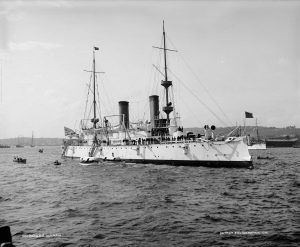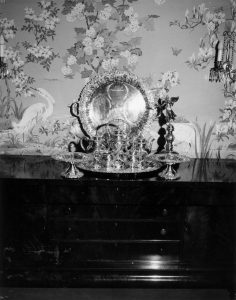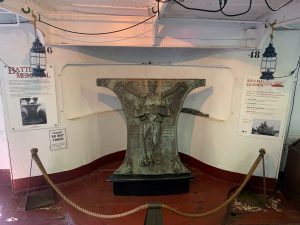On May 1, 1898, the United States won its first major engagement of the Spanish-American War at Manila Bay in the Philippines. The American fleet’s flagship, the USS Olympia, was for a brief moment the most famous ship in the world. It was named for the City of Olympia.

The USS Olympia was built during a period of great change in American naval policy. The days of wooden sailing ships dedicated to coastal defense were passing, replaced by steamships. The Olympia was the first of the Great White Fleet – named for the color of their hulls – meant to “show the flag” around the world and protect American political/economic interests.
The ship’s keel was laid on June 17, 1891 in San Francisco. A marvel of modern naval engineering, it was 344 feet long, with a beam measuring 53 feet. The vessel’s displacement was 5,870 tons, and it could make 22 knots. The ship was powered with coal-burning steam engines. At first the vessel was called Cruiser No. 6, but it needed a permanent name.
Naming the USS Olympia
The Navy settled on Olympia. “He [Secretary of the Navy Benjamin Tracy] honors our city,” proclaimed the Morning Olympian, publishing a special dispatch from San Francisco on October 14, 1892. The newspaper credited the name to Senator Watson Squire of Washington, who in turn credited John McGraw, future governor of Washington.
Writing the next day, the Morning Olympian editors hoped that the name would be, “not merely an empty honor but one that would advertise this city wherever the cruiser steamed, and that to Olympia such an advertisement would be of far more relative importance than to the larger cities after which naval vessels have heretofore been named, as it would serve to attract the attention of many to this city who would not be likely to think of it otherwise.”
The ship was officially launched on November 5, 1892. It was assigned to the Asiatic Squadron.
The Battle of Manila Bay
In February 1898 the USS Maine exploded in Havana Harbor, Cuba, a Spanish colony. Although later deemed likely an accident, the United States declared war against Spain. A fleet was sent to attack the Philippines, another Spanish colony. The Olympia was chosen as Admiral George Dewey’s flagship. On May 1, the American fleet won a decisive victory against Spanish defenders at Manila Bay.
News of Dewey’s victory was greeted with great excitement. “Victory Crowns Olympia,” ran the headline on the May fourth edition of the Morning Olympian. A mass meeting was held that day with patriotic speeches and singing. Mayor George Lane wired the ship, “Congratulations of mayor and citizens.” It was among the first telegraphs read to the crew.
A Souvenir for the USS Olympia

People in Olympia eagerly followed the ship’s further fortunes as it returned to the United States. While local people had talked about creating a proper memento or souvenir to give the ship soon after the vessel was built, they had never decided on what to do. On December 7, 1893 Sheridan Camp No. 24 of the Sons of Veterans gave a musical performance at the Olympia Theater to raise money for a gift to the ship. The Leighton band played the “U.S. Cruiser Olympia March” and ex-mayor Rossell O’Brien sang “Some Day.” The Ladies Relief Society even held a whist party at the Hotel Olympia to raise funds the next month, but a souvenir was not forthcoming.
After the ship’s victory at Manila Bay, this failure became an embarrassment, although Olympia women sent Admiral Dewey a set of napery, household linen. On May 14, 1898, an official memorial committee issued an appeal to the people throughout the state.
The committee commissioned a silver dining service and memorial plaque. The plaque depicts a woman representing fame holding a banner with Dewey’s famous line from the Battle of Manila, “Gridley, You May Fire When Ready,” which began the fighting. Charles Gridley commanded the Olympia at the time.
While some criticized the plaque’s simplicity – and $1,700 cost – others called it a work of genius. The memorial committee wanted to use the fund’s balance for a replica but deemed the $500 the company asked too expensive.
The silver service was created using silver and gold bullion from Washington mines by Shreve and Company in San Francisco, costing $8,750. Both the plaque and silver service were presented to the Olympia during the ship’s trip to New York in September 1899.
USS Olympia: Later Years and Preservation

Over the years, people in Olympia kept a careful watch on the ship’s career. The Governor wanted the ship to join the naval reserve or serve as a National Guard training site on Puget Sound. Or, if the ship were decommissioned, to return the plaque for display in the capitol building. Instead, the vessel was used to train cadets at the Annapolis Naval Academy.
The USS Olympia went back into active service during World War I, patrolling the North Atlantic. It later took part in the American intervention in the Russian Revolution and made a goodwill tour of the Eastern Mediterranean. After bringing the Unknown Solider to the United States, the ship was decommissioned in 1922.
In 1954, the Cruiser Olympia Association formed to preserve the ship. Today the ship is open to the public at the Independence Seaport Museum in Philadelphia, taken care of by many dedicated volunteers. While there has been some discussion of moving the ship to Olympia, that has proved impractical. The USS Olympia remains on the East Coast, receiving numerous visitors attracted by its historic significance. In the words of an 1892 Morning Olympian toast, “Long may the Olympia float.”















































